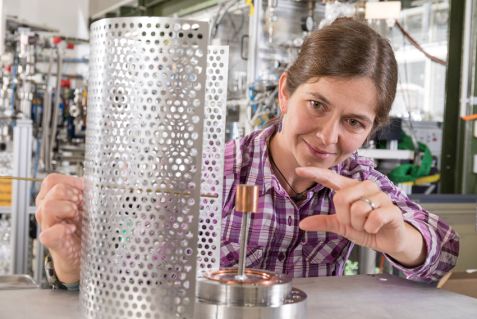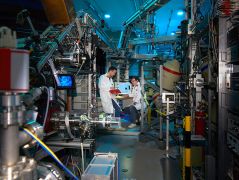MLZ is a cooperation between:
 > Technische Universität München
> Technische Universität München > Helmholtz-Zentrum Hereon
> Helmholtz-Zentrum Hereon
 > Forschungszentrum Jülich
> Forschungszentrum Jülich
MLZ is a member of:
 > LENS
> LENS > ERF-AISBL
> ERF-AISBL
MLZ on social media:

MLZ (eng)
Lichtenbergstr.1
85748 Garching
15.12.2018
Trapped antimatter

Dr. Eve Stenson uses spare parts to demonstrate the structure of the prototype trap: in the centre is the permanent magnet, the wire on the left represents a probe that can be inserted into the trap. It allows researchers to determine the quantity of injected particles successfully captured inside the magnetic field. © A. Griesch / IPP
For the first time, scientists of the Technical University of Munich (TUM) and the Max Planck Institute for Plasma Physics (IPP) have trapped positrons in a magnetic cage without losses. This is an important step towards a matter-antimatter plasma of electrons and their antiparticles, the positrons, which are assumed to occur in the vicinity of neutron stars and black holes.
The APEX (A Positron-Electron Experiment) group at the IPP aims to create a matter-antimatter plasma of electrons and their antiparticles – known as positrons – and to confine it in a magnetic cage for the first time. To do this, they first need to transport the charged particles into a magnetic field cage. The researchers have now achieved their objective using an almost lossless method, as reported in Physical Review Letters by former IPP and now TUM scientist Dr Eve Stenson at the Heinz Maier-Leibnitz Zentrum and Dr. Christoph Hugenschmidt (MLZ, TUM). They succeeded in confining the positrons in the magnetic trap for more than a second, as described in a second article by Dr Juliane Horn-Stanja with the same team..
To achieve these good results, a great deal of research was needed because the same mechanism that holds the charged particles in the magnetic cage also prevents them from entering the cage from the outside. Instead, the particles are deflected away from the trap. Moreover, the particles must be injected into the trap as loss-free as possible, because positrons – unlike electrons – are not available in unlimited quantities; they are obtained in a complicated production process. This is the job of NEPOMUC, the world’s most powerful positron source, which is located in Garching at the FRM II Research Neutron Source of the Technical University of Munich.
To overcome this challenge, researchers performed extensive simulations and then verified them experimentally: a tailor-made electric field at the edge of the magnetic trap ensures that the charged particles can drift into the trap across the magnetic field lines. The electric field is then switched off and the particles are trapped in the magnetic field. An opposite example of this effect is seen in fusion research: electric fields, which can form spontaneously in the plasma, cause unwanted drifting of particles out of the confining magnetic cage – a particle loss which fusion researchers prevent by using a variety of countermeasures.
The current experiments used a prototype trap with a simple permanent magnet, which was attached to NEPOMUC. To generate an electron-positron plasma, however, the APEX group is working on a superconducting dipole that floats in the middle of a vacuum chamber without touching the walls and generates the confining magnetic field. The desired matter-antimatter plasmas of electrons and positrons are thought to exhibit extraordinary properties. As they are assumed to occur in the vicinity of neutron stars and black holes, these peculiar plasmas represent an interesting topic of study not only in basic research but also in astrophysics.
Text: IPP
Original publications:
Lossless Positron Injection into a Magnetic Dipole Trap.
E. V. Stenson, S. Nißl, U. Hergenhahn, J. Horn-Stanja, M. Singer, H. Saitoh, T. Sunn Pedersen, J. R. Danielson, M. R. Stoneking, M. Dickmann, C. Hugenschmidt
In: Phys. Rev. Lett. 121, 235005 – Published 5 December 2018
DOI: https://doi.org/10.1103/PhysRevLett.121.235005
Confinement of Positrons Exceeding 1 s in a Supported Magnetic Dipole Trap.
J. Horn-Stanja, S. Nißl, U. Hergenhahn, T. Sunn Pedersen, H. Saitoh, E. V. Stenson, M. Dickmann, C. Hugenschmidt, M. Singer, M. R. Stoneking, and J. R. Danielson
In: Phys. Rev. Lett. 121, 235003 – Published 5 December 2018
DOI: https://doi.org/10.1103/PhysRevLett.121.235003
Related News
More information:
Partner in the project were the Technical University of Munich (Germany), the Max Planck Institute for Plasma Physics, Garching and Greifswald (Germany), the Leibniz Institute of Surface Engineering (IOM), Leipzig (Germany), University of Greifswald (Germany), the University of Tokyo (Japan), University of California, San Diego (USA) and the Lawrence University, Appleton (USA).
This project has received funding from the European Research Council (ERC), the German Research Foundation (DFG), the Helmholtz Association Postdoc Program, the UC San Diego Foundation, the Collaboration Research Program of the Japan National Institute for Fusion Science (NIFS) and the Japan Society for the Promotion of Science (JSPS).
MLZ is a cooperation between:
 > Technische Universität München
> Technische Universität München > Helmholtz-Zentrum Hereon
> Helmholtz-Zentrum Hereon
 > Forschungszentrum Jülich
> Forschungszentrum Jülich
MLZ is a member of:
 > LENS
> LENS > ERF-AISBL
> ERF-AISBL
MLZ on social media:




